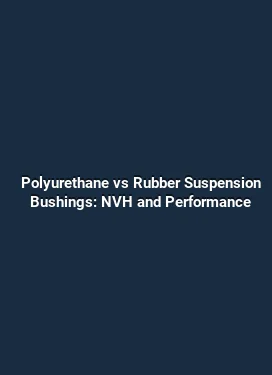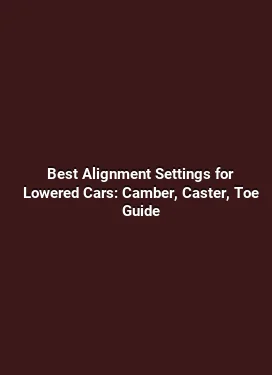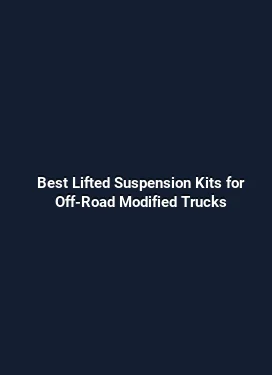Best Rear Trailing Arm Bushings for Drift and Track Cars
In the realm of performance suspension, the rear trailing arm bushings play a pivotal role in how a car communicates with the road during aggressive driving. For drift enthusiasts and track-day participants alike, selecting the right bushing material and geometry can dramatically alter rear toe behavior, axle stability, and the vehicle’s overall balance through high-load corners. This guide dives into how different bushing constructions affect grip, steering response, and consistency under repeated high-load cycles, while offering practical fitting tips and real-world testing insights from experienced drifters and racers.
The trailing arm bushing is not simply a wear item; it is a dynamic interface that negotiates movement, torque transfer, and vibration dampening between the suspension arm and chassis. As cornering forces rise, bushings must accommodate angular deflection without allowing excessive play that would undermine precision. Conversely, too stiff a setup can increase harshness and magnify chassis chassis-to-axle load transmissions, reducing traction during mid-corner transitions. The sweet spot lies in choosing a material and geometry that suits the car’s intended discipline, the driver’s style, and the track or drift conditions.
Understanding Trailing Arm Bushing Roles and Load Paths

Trailing arms connect the wheel hub to the chassis and control longitudinal and lateral movement of the axle. The bushings manage three primary load paths: vertical forces from weight transfer, lateral forces during cornering, and angular movement as the suspension articulates. In high-power drift or track scenarios, the rear axle experiences significant torque during throttle lift or aggressive corner exits. This torque tends to rotate the arm around the bushing, which can introduce toe-in or toe-out changes at the rear wheels. A well-chosen bushing minimizes unwanted toe changes, preserves predictable load transfer, and helps maintain balance between oversteer and understeer characteristics.
Material selection determines how a bushing responds to heat, moisture, and aging. Elastomer blends offer a balance of compliance and isolation, while polyurethane provides higher stiffness and quicker response at the cost of increased NVH (noise, vibration, and harshness). Solid or semi-spherical bearings reduce deflection further but require careful tuning to avoid excessive harshness. Understanding these trade-offs is essential for choosing a setup aligned with the car’s suspension geometry and the driver’s preferences.
Materials and Geometry: How Bushings Influence Handling
Several common materials and geometries dominate the trailing arm bushing market, each with distinct characteristics that influence drift and track performance. Elastomer blends are the traditional choice, delivering decent compliance to absorb road irregularities while maintaining predictable geometry. Polyurethane offers stiffer, more linear response and better resistance to wear, particularly under high lateral loads. Delrin and other high-performance polymers push stiffness even further, reducing deflection at the cost of higher vibration transfer. In some setups, metallic or hybrid bushings with embedded bearings provide the lowest possible deflection, giving the most immediate feedback but often demanding complementary damping to prevent harshness.
Beyond material, the bushing’s inner and outer shapes matter. Cushioned, oversized sleeves can reduce peak shear stress and improve longevity under high-speed cornering. Some designs employ a radial slot or cross-axis geometry to accommodate controlled elasticity while limiting lateral play. A solid, well-anchored bushing maintains alignment under load, reducing drift-induced yaw and helping the driver place the rear of the car more precisely through turns. The upshot is a more progressive entry into corners, with less mid-corner instability as power grows and grip varies with tire temperature.
Comparative Overview: Elastomer vs. Polyurethane vs. Solid Bearings

Elastomer bushings aim for a smooth ride and quiet operation. They work well on street-driven cars or track cars that prioritize comfort along with performance. They tend to mitigate drivetrain vibrations and provide ample compliance to avoid harshness in rough sections. However, elastomer can smear under high lateral loads, allowing more toe change and potentially a softer rear feel during aggressive entries.
Polyurethane bushings offer a stiffer response with improved shear strength. They reduce deflection under load, translating to crisper turn-in and more consistent toe position across a session. This consistency is valuable for drift setups where precise rear torque management matters. The trade-off is elevated NVH, especially on coarse surfaces, and increased sensitivity to alignment tolerances.
Spherical or Bearing-Type bushings minimize angular play by using a ball-in-socket interface or embedded bearings. They deliver the most direct feel and repeatability, which is highly desirable on track days and in competitive drifting. The downsides include more transmission of road imperfections and a potential increase in wear if not paired with adequate damping or proper maintenance. For cars with aggressive alignment specs or harsh suspension geometry, spherical bushings are a common choice for the rear to achieve predictable pivot behavior.
Alignment, Geometry, and Setup Considerations
Trailing arm bushings influence alignment retention after a corner or a bump. When a bushing compresses or twists, toe and camber can shift subtly, altering how the rear tires contact the track. Builders focusing on drift and track performance often couple bushing selection with specific alignment goals. For example, a setup designed to promote oversteer at the limit may tolerate a touch more rear toe-out in mid-corner, while a track-oriented layout might emphasize rear toe stability to preserve rear grip during mid-corner push. The choice of bushing material interacts with these goals by either dampening shifts or allowing rapid, controlled movement.
In practice, this means performing a formal alignment and then validating through measured trail runs on the track. Pay attention to how rear toe evolves under throttle application, braking, and suspension compression during corner exit. If toe is drifting toward the inside or outside too aggressively, consider revisiting bushing selection, stiffness, or the use of compliant mounts in order to maintain the intended handling balance throughout the corner. Visual cues such as tire wear patterns and progressively worsening or improving grip can also guide tuning decisions.
Practical Fitting Tips and Maintenance
Before installing new rear trailing arm bushings, inspect the chassis mounting points for play and corrosion. Clean any debris, lubricate properly where applicable, and verify that the trailing arms themselves are not bent or damaged. When selecting bushings, choose a part that precisely matches the arm diameter and bore hole size to avoid slippage or misalignment. Some aftermarket bushings require a small amount of trimming or a specific installation tool to achieve a true, concentric fit. Always follow the manufacturer’s torque specifications and use appropriate fasteners with the correct thread pitch to ensure a stable mount.
During installation, consider the following steps: (1) support the vehicle securely to prevent movement; (2) remove the components without introducing torsional stress into the arms; (3) install the bushings with the correct orientation if there are directional features; (4) verify that the arm moves freely without binding after initial assembly; (5) re-check alignment after a short drive for settling and any changes in suspension geometry. After racing or drifting sessions, inspect bushings for wear signs such as cracking, cracking, or splitting, and replace them before they become a source of unpredictable handling.
Real-World Scenarios: Drift and Track Car Applications
In drift cars, rear stability during transitions is critical. A bushing setup that reduces rear toe fluctuations during aggressive slides can help a driver maintain predictable yaw response and easier throttle modulation. Riders often seek polyurethane or hybrid bushings to achieve a more direct feel without harshness, enabling precise placement of the rear axle relative to the chassis. The goal is to have the rear tires maintain traction as the front end wings through the apex, allowing for controlled drift angles and consistent exit power.
On track cars, repeatability across sessions matters more than instantaneous feedback. In this context, robust bushings that resist heat-induced degradation and maintain geometry under repetitive cornering provide a more stable baseline for lap times. In some cases, teams retrofit solid or semi-spherical bushings for the rear to secure the precise attitude of the car through high-G cornering and over a wide range of track surfaces. The payoff is a car that keeps the same rear alignment footprint session after session, which translates into more predictable brake bias, tire behavior, and driver confidence.
What to Look for When Choosing Rear Trailing Arm Bushings
Start with compatibility: ensure the bushing design matches the trailing arm’s bore size, inner sleeve, and mounting method. Next, consider the driving profile. Drifters often prioritize a balance between quick response and stability in transitions, favoring stiffer compounds with deliberate deflection control. Track cars, especially those in endurance or sprint formats, tend to benefit from bushings that maintain geometry under heat and repeated cycles while keeping NVH within acceptable limits for the drivers.
Durability is another critical axis. Heat resistance, aging characteristics, and resistance to environmental exposure (oil, moisture, road salts) determine long-term performance. Inspect the bushing’s surface finish and bonding method: bonded elastomer vs. hollow-core polyurethane, etc. A well-bonded, properly cured material will resist cracking and slippage better under high-load conditions. Finally, consider upgrade options such as solid inner sleeves, dual-durometer constructions, or bearing-enabled designs if the chassis and drive train can support the extra stiffness and damping control.
Installation Guide: A Step-by-Step Path to a Safer, More Predictable Rear
A methodical installation can extract the full potential from new trailing arm bushings. Begin with a thorough vehicle lift, inspection, and safety checks. Remove the rear suspension components with attention to torque sequences to avoid warping the mounting points. Inspect bushings and sleeves for wear or damage and replace as needed. Clean the bore holes and apply any recommended lubrication only where specified by the manufacturer. Install the bushings with the correct orientation, ensuring the inner sleeves are properly seated.
After installation, perform a controlled alignment check and road test to confirm there are no binding sensations and that the rear end tracks in a straight line under varying throttle and braking conditions. If any unusual noises or vibrations appear, recheck the fasteners and the bushing seating. A brief bedding-in period allows the new components to settle and helps reveal any installation issues before track usage.
Conclusion: The Right Rear Trailing Arm Bushing Begins with Clear Goals
Though the topic can seem technical, the core decision hinges on a simple question: how does the rear suspension communicate with the chassis under load, and how stable must that communication be across a session of drifting or competitive laps? By aligning bushing material, geometry, and hardness with the car’s suspension topology and the driver’s preference, a drift or track car can achieve a more predictable rear balance, consistent tire wear, and better control during high-load maneuvers. The result is a chassis that responds as a direct extension of the driver’s intent, with rear-end behavior that remains within the desired range from entry to exit of every corner.






